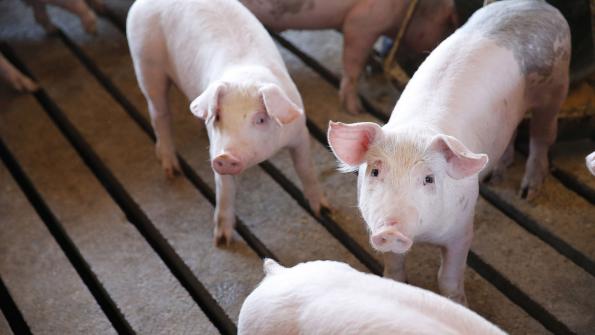During the Carthage Veterinary Service Swine Conference, Silva outlined several strategies for wean-to-finish producers.

Last year when several U.S. pork processors announced they planned to go "ractopamine-free" to capitalize on export opportunities, the decision left many wean-to-finish operations looking for an alternative. But as Gustavo Silva pointed out Tuesday during the Carthage Veterinary Service 30th Annual Virtual Swine Health and Production Conference, there is no "silver bullet" substitute.
"It was awesome to use this because it could improve everything from average daily gain to carcass leanness, but unfortunately we are not using this product anymore and we will need to focus on the basics," says the Iowa State University fellow who is currently partnering with the Carthage Innovative Swine Solutions team.
A synthetic β-adrenergic agonist, ractopamine was used to increase average daily gain, improve feed efficiency and increase carcass leanness. Included in diet formulations around 21 to 35 days of age, the feed additive redirected nutrient utilization toward lean gain and away from fat deposition. A typical response from feeding ractopamine to finishers included a 12% improvement in ADG, 10% to 16.7% improvement in feed efficiency and 3.3% to 5.5% improvement in carcass leanness.
With plants shying away from processing hogs fed ractopamine, Silva says there are some strategies wean-to-finish growers can utilize to minimize losses.
Barn management
Make sure to have the correct phase feeding program at the right time. Adjust feeders to minimize feed wastage. A 1% reduction in feed wastage can save $0.71 per pig marketed. Keep appropriate feeder space width, as that will improve FE. Preserve proper stocking density. For each 3% reduction in space, ADG and average daily feed intake will decrease by 1%. Maintain barn temperature. For every 1.8-degree F increase in environmental temperature, feed intake will reduce by approximately 2% in weight.
Split-sex feeding
Barrows and gilts have different nutrient requirements. The rate of protein deposition in barrows is greater than in gilts, requiring more grams of amino acid intake per day, especially after 14 weeks of age. When formulating for mixed groups, one group is overfed and the other underfed. Split-sex feeding will maximize the growth performance in each group. The savings in feed cost can range from $0.25 to $0.40 per pig. However, Silva cautions producers before utilizing this strategy to consider pig flow, barn setup and feed manufacturing budgets.
Feed processing
Grain particle size and feed form (mash or pellet) can play a part in feed efficiency. According to Silva, particle size can improve FE by 1% for every 100 microns decrease in particle size from 900 to 300μm. "One thing that we need to be aware is that when we go to diets below 450 microns, we can have problems with feed flow, and also with gastric ulcers," Silva says.
Pelleting can also improve FE by 4% to 6%, as well as improve digestibility and feed wastage, but Silva cautions producers as the feed form can increase manufacturing costs and pellet quality can be inconsistent.
Immunological castration (Improvest)
The product reduces the levels of androsterone and skatole in mature male pigs, which are the primary source of "boar taint" in male pigs. Male pigs can then fully express their natural potential for feed-efficient growth. It was approved by the U.S. Food & Drug Administration in 2011 and requires a veterinary prescription to ensure proper handling, administration and tracking. While the product is used around the globe and producers can obtain improvements in ADG of 4% and FE of 8%, Silva says it is not well stablished in the United States.
Feed additives
Different strategies for grow-finish phase include growth promoters, enzymes (phytase, carbohydrases, proteases, etc.), acidifiers, direct-fed microbials, essential oils and medium-chain fatty acids. Silva says results with these products have been variable though and adding these to diets may increase feed costs. It is important to establish breakeven cost for the additive in question before implementation.
Diet restriction
Compensatory gain is a period of restriction (feed intake or amino acids, etc.) followed by a period of recovery. Silva says compensatory gain can be incomplete, complete or non-existent and that is why there is so much variation in results. If the restriction time is too long or severe and the compensatory period too short, compensatory growth may not occur. The number of dietary phases and nutrient fortification should be carefully evaluated by a nutritionist, Silva says.
Disease elimination
Diseases impact feed intake, thus ADG and FE. For example, a Mycoplasma hyopneumoniae disease elimination program can increase ADG anywhere from 3% to 16% and improve FE by 3%. With porcine reproductive and respiratory syndrome disease elimination, ADG improved 30% (challenged non-vaccinated pigs) and FE 8.2% (challenged non-vaccinated pigs).
"There's no strategy available in the market like ractopamine," Silva says. "When we're evaluating the strategies that are available in the market, use the return over investment and see if that is worth it and the risk is worth it, and then implement ones that have more likelihood of success after considering your barn or system settings."
About the Author(s)
You May Also Like





